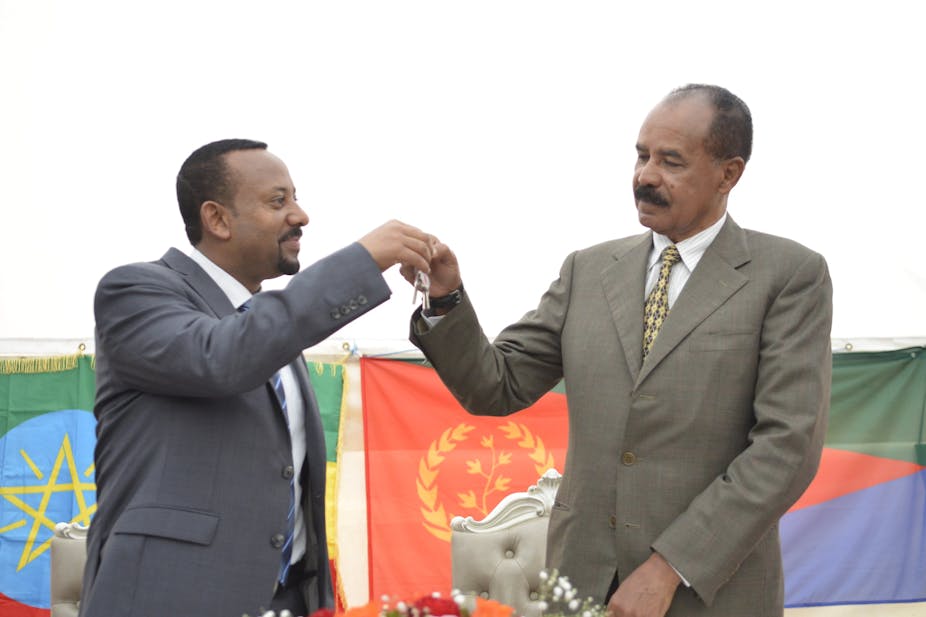Exactly a year ago Eritreans could hardly contain their joy as Ethiopian Prime Minister Abiy Ahmed touched down in Asmara. The city had seen nothing like it in a generation that knew war rather than peace. Men and women lined the streets and waved Ethiopian flags as Abiy arrived to seal a peace deal.
Less than a week later Eritrea’s president Isaias Afwerki made a reciprocal visit, landing in Addis Ababa to an equally rapturous welcome. In September a formal treaty was signed between the two leaders in the Saudi capital, Jeddah, witnessed by King Salman and the UN Secretary General, Antonio Guterres, who described it as an “historic event.”
The treaty covered a number of things. It ended the state of war between Eritrea and Ethiopia; declaring a new era of peace, friendship and comprehensive cooperation.
As part of this deal, there were two important provisions. One called for “the establishment of joint special economic zones. The other was a pledge to establish a high-level joint committee, as well as sub-committees where needed to guide and oversee the implementation of this agreement.
But there has been little apparent progress on either front. Economic co-operation was probably one of the key drivers of this reconciliation. These included plans to develop a massive potash mine that would straddle the border. But little has been heard of the project in recent months.
Much the same can be said of the joint committees that were given the job of sorting out the many issues bedevilling relations between the two countries.
What’s become clear is that the warmth of a year ago has largely gone. With little progress on implementing and institutionalising the relations between the two countries an air of uncertainty and suspicion is creeping back.
Disputed border
One of the sticking points between the two countries is the disputed border. The border was formally designated by the Boundary Commission established after the 1998–2000 border war. The conflict had many causes: rivalry between the liberation movements that had been operating in both countries and economic competition. But it was competing claims to the insignificant border town of Badme that was the spark that ignited the war.
The two countries signed what became known as the Algiers Peace Agreement in 2000. The agreement made clear that the boundary commission could only make decisions based strictly on legal and historical grounds. This barred it from being able to allow for what might be considered just and fair – what’s known as ex aequo et bono.
As a result, the border the Boundary Commission came up with resulted in settlements being dissected and villagers separated from their farmlands. And it left some people on both sides of the border concerned at being transferred from one state to the other.
Changes could only be made by both countries agreeing to any adjustments. This was one of the questions that the joint commissions agreed to in Jeddah was meant to resolve. Others included the terms of trade between Eritrea and Ethiopia, for example exchange rates and economic relations which were seen as important contributing factors in the 1988 – 2000 border war.
Distractions
Rather than working to consolidate the peace, the leaders of both countries have drifted elsewhere. Ethiopia has been caught up in increasingly complex and bloody ethnic conflicts that have driven more than a million people from their homes. Coming to grips with this is taking much of Abiy’s time and attention.
He has also been working on behalf of the African Union to help resolve the political crisis in Sudan. Eritrea’s Isaias has also been to Sudan, but with a rather different remit. Welcomed warmly by by the deputy chairman of the Transitional Military Council, General Mohamed Hamdan Dagalo "Hemetti”, Isaias issued a statement that showed his agenda was quite different, as shown by his recent statement:
The Government of Eritrea requests the AU to refrain from internationalising and exacerbating the situation in Sudan.
His approach isn’t difficult to understand. Isaias enjoys strong relations with Saudi Arabia and the UAE both of which have been embroiled in a war in Yemen. Eritrea has allowed its ports and airfields to be used by both countries to prosecute this war. At the same time the Sudanese military provide troops to fight in Yemen and have been open in their support for the Saudi and UAE in their war aims.
Saudi Arabia was therefore alarmed at the challenge posed to the Sudanese government by the popular uprising in Khartoum and other Sudanese towns and cities.
Border remains tense
Even though the glow of last year’s events has faced, Eritrea has nevertheless reaped many gains from the rapprochement with Ethiopia. One consequence is that it signalled the end of its international isolation. Limited United Nations sanctions were lifted and the country now holds a seat on the UN Human Rights Council, a body that frequently criticised its lack of adherence to international human rights norms.
Eritrea has also taken the chair of the Khartoum Process. This is a critical position, since it is the key forum in which African states negotiate with the European Union.
But the situation along the Ethiopia-Eritrea border remains tense. The Ethiopian government attempted to move its heavy artillery away from the border, but this was blocked by local residents of Tigray, fearful that there might be renewed conflict with Eritrea.
Their concerns are hardly surprising. Isaias has made vituperative statements about his immediate neighbours, describing the Trigrayan ruling party - the TPLF – as “vultures”, and accusing them of following a “toxic and malignan” agenda.
It is difficult to know how relations between Addis Ababa and Asmara will develop. The fear is that Isaias has gone back to his unpredictable ways, making any predictions difficult.

